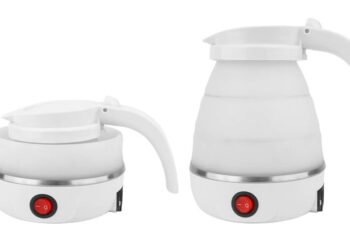Wander and Experience is reader-supported. When you buy through links on our site, we may earn an affiliate commission.
Planning a trip and considering the Japan Rail Pass for your trip? This ultimate Japan Rail Pass guide helps to answer any question you have on how the pass works, which pass to get, and where to order your pass.
While the Japan Rail Pass is one of the best travel tools available for those traveling to Japan, simple mistakes or poor planning can limit savings or cause visitors to overpay for rail tickets. Read through and inform yourself on the critical factors to determine if a Japan Rail Pass is right for your itinerary.
Read our other Japan Rail Pass posts for more tips and ways to get the most from the pass:
Is the Japan Rail Pass Worth It?
The 20 Best Places to Visit with the Japan Rail Pass
10 Japan Rail Pass Mistakes to Avoid
How does the Japan Rail Pass Work?
The Japan Rail Pass is a countrywide rail pass that allows for unlimited travel across Japan in 7, 14, or 21 day periods on rail lines run by the Japan Railways Group, which consists of six regional railways in Japan.
Available only to foreign tourists visiting Japan, the Japan Rail Pass, also known as the JR Pass, provides visitors with an easy way to get around the country and an excellent value for those with itineraries that include multiple long-distance rail journeys.
Passes are available as an Ordinary Pass or a Green Pass, a premium travel class, with designated Green Cars on trains such as the Shinkansen, known to many as the bullet train, as well as on limited express trains.
The passes allow travel on most railway lines and services operated by Japan Rail Pass, including the Shinkansen lines and the Narita Express Train from Narita International Airport to Tokyo. In addition to the rail services, the pass can also be used on JR local buses and the JR Miyajima Ferry.
How much does the pass cost?
The Japan Rail Pass pricing is split between Green and Ordinary passes; 7, 14, and 21 Day Passes for each; and whether the pass is for adults or children aged 6-11 years old.
There are also two sets of prices, the lowest prices are for passes sold by authorized sales agents of the Japan Rail Pass, with the prices set by Japan Railways Group. There are a number of agents like JR Pass, which is an online sales agent that can ship all over the world.
The other price grid is for passes sold directly from Japan Railways Group, which come in at 10-13% more expensive than the authorized sales agents.
Japan Rail Pass Prices from Authorized Sales Agents
| Type | Green | Ordinary | ||
|---|---|---|---|---|
| Duration | Adult | Child | Adult | Chiild |
| 7-Day | ¥39,600 | ¥19,800 | ¥29,650 | ¥14,820 |
| 14-Day | ¥64,120 | ¥32,060 | ¥47,250 | ¥23,620 |
| 21-Day | ¥83,390 | ¥41,690 | ¥60,450 | ¥30,220 |
Japan Rail Pass Prices for Buying Direct from Japan Railways Group
| Type | Green | Ordinary | ||
|---|---|---|---|---|
| Duration | Adult | Child | Adult | Child |
| 7-Day | ¥44,810 | ¥22,400 | ¥33,610 | ¥16,800 |
| 14-Day | ¥72,310 | ¥36,150 | ¥52,960 | ¥26,480 |
| 21-Day | ¥91,670 | ¥45,830 | ¥66,200 | ¥33,100 |
What about small children 5 years old and younger?
Japan Rail Group does not require a rail pass for children up to 5 years old, though the child will not be allocated a seat. These small children can sit in an empty seat if available, though if the train is full, they will be required to sit on the adult’s lap.
Due to this limitation, one adult must be present per child traveling without a pass. This option helps families looking to save money, though those looking for the comfort and assurance of having a seat for their child can opt for the Child Pass. This is recommended during busier times, especially if traveling over public holidays.
Where can the pass be used?
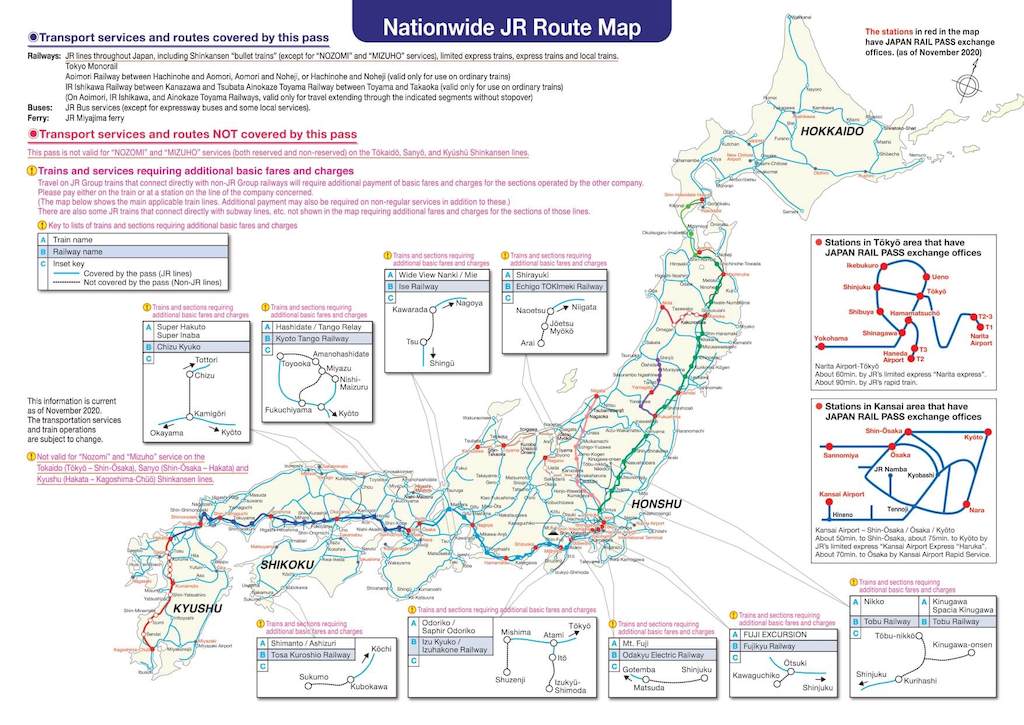
Passholders can use the Japan Rail Pass on Japan Railways Group trains across the main islands of Japan: Hokkaido, Honshu, Shikoku, and Kyushu. A wide range of train lines crisscross these islands, from local trains to limited express trains to the Shinkansen, often referred to by visitors as the bullet train, due to the bullet-like nose of the front of the trains.
The pass is also valid on local lines of JR Buses across the country and the JR West Miyajima Ferry in Hiroshima, which takes visitors to one of the city’s top attractions.
The Japan Railways Group consists of six independently operated railways that were split into regional railways during the Japan National Railway privatization in 1987.
The Japan Railways Group railways:
It’s worth noting that while the regional railways that make up the Japan Railways Group offer by far the most extensive coverage and fastest trains in Japan, regionally and locally, several other rail operators run lines on which the pass is not valid.
Are there any exclusions?
Rail journeys on the Nozomi and Mizuho limited express Shinkansen services are the only exclusions for the pass. These are Shinkansen services with fewer stops, requiring less time between destinations. Though, the impact to pass-holders is relatively limited over long distances.
The Nozomi Shinkansen takes 2 Hours and 30 Minutes from Tokyo to Kyoto, with the Hikari Shinkansen taking 2 Hours and 10 Minutes.
While the Sakura Shinkansen takes 4 Hours and 20 Minutes between Osaka and Kagoshima, instead of the 3 Hours and 50 Minutes on the Mizuho Shinkansen.
How do you purchase a Japan Rail Pass?
There are three ways to buy a Japan Rail Pass: online through the Japan Rail Pass website, through an authorized Japan Rail Pass agent, or at a Japan Rail Pass sales office in Japan.
Buying the pass through authorized Japan Rail Pass agents like JR Pass….. will give you the lowest price of all three options, as the prices have been set by the Japan Rail Group, and are lower than buying directly from the Japan Rail Pass website or sales office.
When you order from an authorized agent like JR Pass….. you will receive a receipt that is referred to as an exchange order in the mail; after you arrive in Japan, you can then take your exchange order to a select Japan Rail Group ticket office listed here to receive your pass.
The ticket offices cover the major rail stations in the country, including international airports.
Is it easier to buy the pass in Japan?
Yes and no. While those who may have missed out on planning to buy a pass before arriving in Japan may still be able to purchase one after arriving, it will be for a higher cost than buying an exchange order before arrival, between 10-13% higher than JR Pass and other agents.
Additionally, Japan Rail Group has only recently started selling the passes in Japan, as they were previously only available to be ordered outside Japan. Sales of passes within Japan are on a trial basis that is not guaranteed to continue and could end by the time you read this.
If you know you need a pass, order one as early as possible to lock in the savings from buying on JR Pass and avoid the risk of not purchasing a pass before arrival.
Who is eligible to purchase a Japan Rail Pass?
To be eligible to purchase an exchange order or a Japan Rail Pass, you must enter Japan and receive a stamp in your passport that indicates you are a ‘Temporary Visitor.’
This designation will apply to most tourists visiting Japan, and the condition is in place to exclude residents of Japan and foreigners staying in Japan under different visas.
The Japan Rail Pass makes it easy and affordable for tourists to visit the country, so the limitations are to avoid pass use for other purposes.
What is the difference between the Ordinary and Green Pass?
The ordinary and green passes correspond with the different train classes for the Shinkansen and limited express trains. There are several minor differences in the classes. However, the most notable differences for consideration are the seat space and legroom, the ability to use non-reserved cars, and the price.
On Shinkansen lines, the ordinary class seats are five seats across in a two-aisle-three configuration, while the green class seats are four seats across in a two-aisle-two design. The photos below show the differences in seating in the two different classes.
With a few inches of additional space for each seat, there is also slightly more legroom and recline on seats in the green class cars.
How noticeable is the seat difference?
An apt comparison is to compare the seat widths of ordinary class to economy class in air travel and green class to premium economy. The legroom for ordinary class is much more than economy class air travel, and green class offers a little more.
Green Class Car on a Shinkansen Train
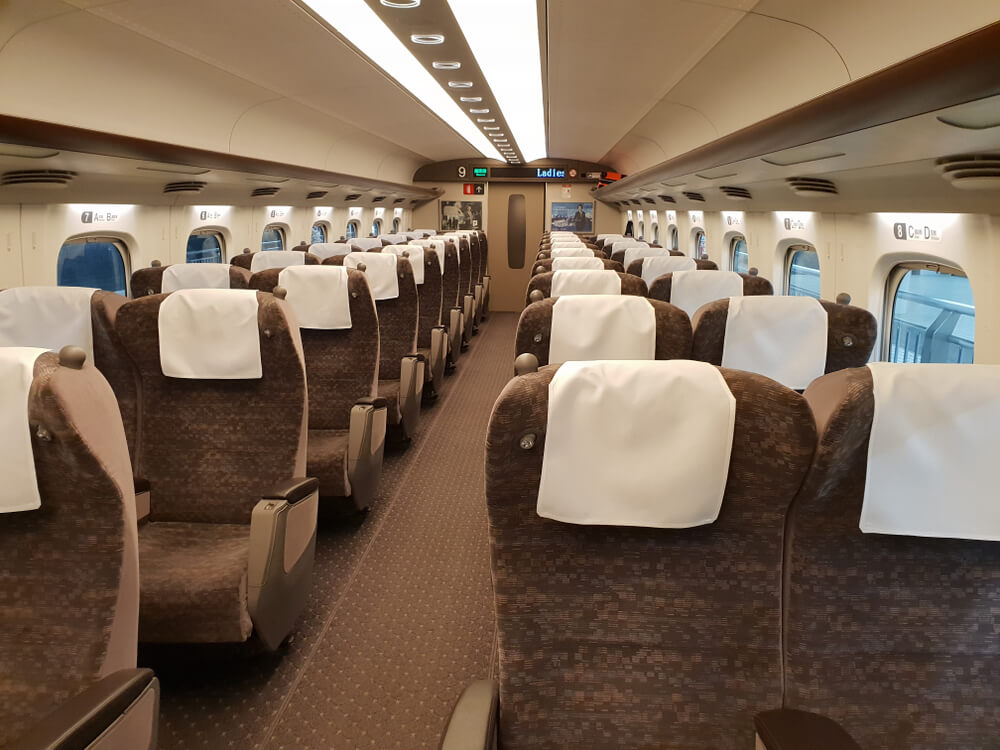
Ordinary Class Car on a Shinkansen Train

Limits on Non-Reserved Seats for the Green Pass
Both Ordinary and Green Pass holders can make seat reservations for their respective seat classes on any eligible train. However, there are no non-reserved green class cars, while there are typically three non-reserved ordinary class cars on each Shinkansen.
Non-reserved cars give pass holders the ability to enter through gates and board a train without a ticket, with any non-reserved seat being free to use.
While Green Pass holders can also use the non-reserved ordinary class cars, there will not be the wider, more comfortable seats that the premium price of the pass entitles the holder to.
Price Differences Between Green and Ordinary Passes
The Green Pass is between 33-37% more expensive than the Ordinary Pass. This price difference is most likely the essential consideration for most travelers.
If the price premium over the ordinary pass is not a concern, and you value the comfortable space, the Green Pass is an easy choice. However, if you are looking for a more affordable way to travel and prefer saving money over a few inches of extra seat space, the Ordinary Pass is better.
Is the Japan Rail Pass worth it?
This is the most crucial question for those considering purchasing the Japan Rail Pass for their trip to Japan, and there is a dedicated post that goes into the details of determining the value for your trip.
Generally, visitors to Japan taking more than one round-trip ticket from Tokyo to Kyoto or a longer distance will find that the Japan Rail Pass will provide savings over standard tickets. It is worth reading through the post to confirm if these considerations will apply to your trip.
How to Use Your Japan Rail Pass
After purchasing and receiving your exchange order, the Japan Rail Pass is straightforward and relatively forgiving to scheduling mistakes and missed trains.
There are four main steps to receive and use the pass:
- Take your exchange order to a Japan Rail ticket office to redeem your pass
- Choose the date for pass activation
- Reserve tickets on trains
- Use the staffed gates to enter the train platforms
Take Your Exchange Order to a Japan Rail Travel Service Center
If you have ordered your Japan Rail Pass for the lowest possible price from authorized agents like JR Pass you will not receive a pass but an exchange order that can be redeemed for a pass.
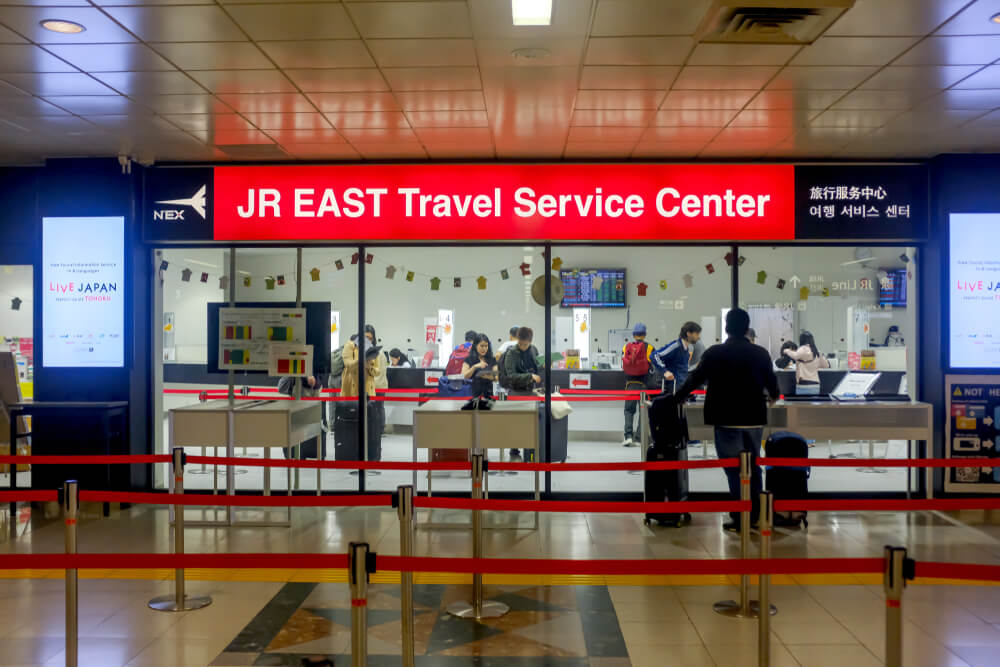
When you arrive in Japan, take the exchange order to a ticket office listed here to redeem your pass. If you arrive at an international airport, you can visit the JR Rail airport ticket office to redeem your pass. Note the operating hours as some may not be open for early or late arrivals.
Choosing a Date to Activate Your Pass
To start using your Japan Rail Pass, you will need to activate the pass; this is a stamp added to your pass to show which dates it will be valid.
If you have a 7-day pass and do not want to use it from your first day of arrival, but rather have it become active three days into the trip, that is fine, and the ticket agent can set a future date at activation so you won’t need to visit again for activation.
Activation can be future dated up to 30 days from when you redeem your exchange order.
Making Seat Reservations with Your Japan Rail Pass
Seat reservations are easy to make with the Japan Rail Pass, as you can make a reservation at any Japan Rail travel service center or ticket office, and you can reserve seats at the time you redeem your exchange order.
When you make a seat reservation, the agent will give you a ticket that can be used for the reservation, though you will still need the pass with the ticket to show to gate staff as you enter the station.
It’s suggested to book tickets as early as possible to avoid your preferred departure times from selling out. If you have a precise itinerary planned, write or print out the train times or numbers before you arrive in Japan to help the agent issue all the tickets you would like.
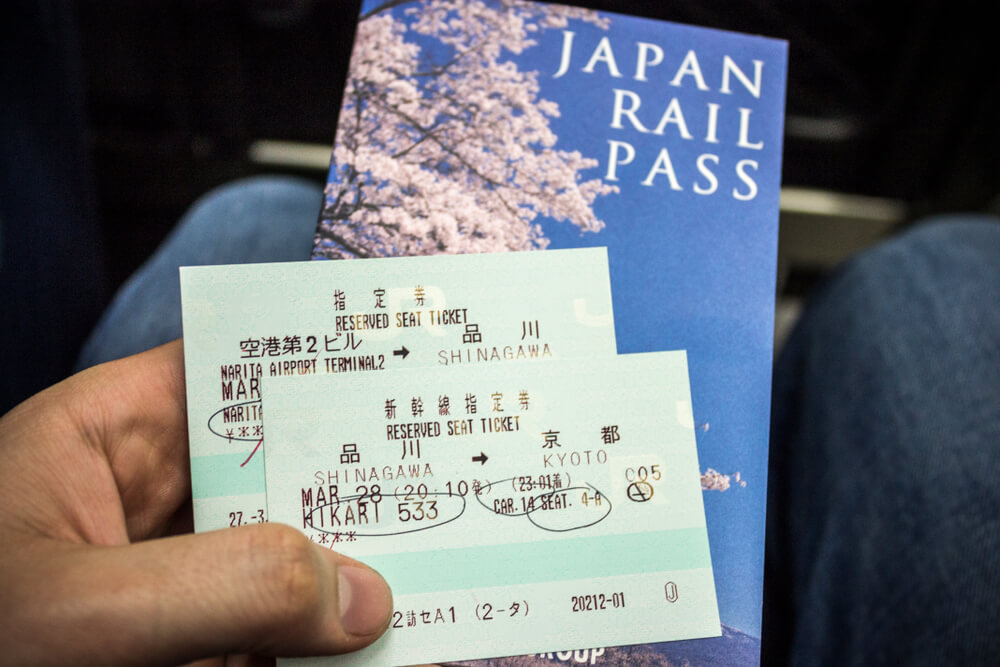
Decide early and change later if necessary, as any Japan Rail ticket office can cancel your previous ticket and reissue a new one if you change your mind before the departure time.
Japan Rail is quite reasonable if you miss a train that you had a reservation on, you can either board a non-reserved car or have a new seat reservation issued for another departure.
It’s worth noting that if you order the Japan Rail Pass through the Japan Rail Pass website, while you will pay a slightly higher price compared to sales agents like JR Pass, you can book seat reservations before arriving in Japan. These early reservations are only necessary for those planning to travel over Japanese holidays, as non-holidays will generally have plenty of seat availability, especially if booked ahead.
Show Your Pass to enter the Train Platforms
Whether you are using a seat reservation or taking a non-reserved car or local train, you will need to enter the train platform by showing your pass to the gate staff.
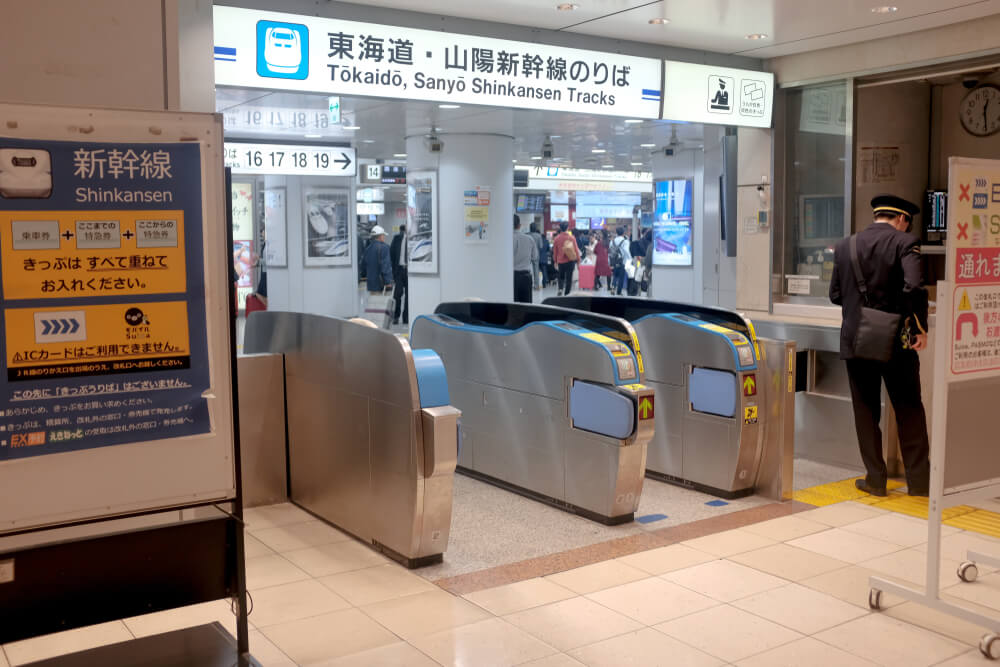
This control allows the staff to confirm that you have a valid pass and prevents lost or stolen tickets from Japan Rail Pass holders from being used without a corresponding pass.
When using your Japan Rail Pass for non-reserved cars or on local trains where there is no seat reservation required, you need to show your pass, and the station staff will check the dates and let you through.
Traveling with Luggage
One of the key challenges for international visitors is traveling with luggage and managing it along the way. There are several different ways to manage luggage for those traveling with bags, though it’s fair to say each has a downside. Find the method that works best for your itinerary.
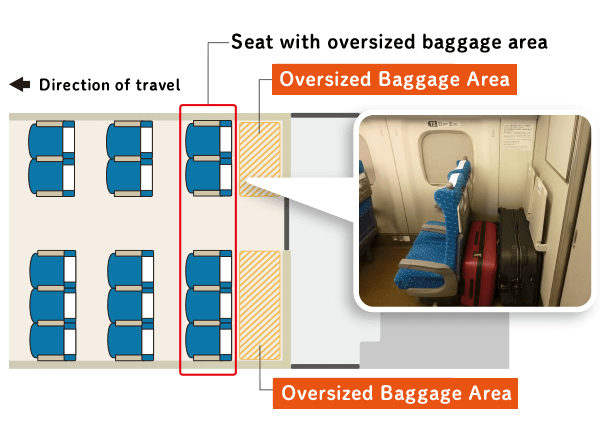
What storage is available for baggage on the Shinkansen?
Along the top of the seats on both sides of the train are overhead shelves that store bags, backpacks, and carry-on-sized rolling luggage. There is also storage for large bags behind the last two seats in each car, though these seats require a specific reservation.
Option One – Limit Your Large Luggage
Those traveling as a couple can limit their large luggage to a single bag, along with a combination of backpacks, totes, and a rolling carry-on. This will help you and your travel partner balance having storage space and managing the bags with a reasonable level of comfort.
Option Two – Store Your Luggage at the Station
Larger Japanese train stations have lockers available for storage; some, like Tokyo Station, can store bags as large as a large rolling suitcase for ¥600 per day. So leaving your large suitcase and any smaller bags at the station before exploring the country is a great way to limit your hassle.
The downside to this strategy is that these lockers are known to sell out, leaving you in a last-minute jam if you were expecting to ditch a bag or two.
Option Three – Leave the Bags at a Hotel
With many Japan Rail Pass users starting and finishing in the same city before flying out, you can plan your itinerary to make sure you have a night in your arrival/departure city on each side of your rail journey. This will allow you to leave extra bags at the same hotel for free.
For example, if you were flying into and out of Tokyo on your flights to and from home, consider booking the same hotel in Tokyo and asking the hotel to hold onto your bags. This will save money on storage and ensure you don’t get to the station to find all the lockers in use.
Make sure you confirm with the hotel before booking any non-refundable reservations. While most hotels in Japan are open to luggage storage, it is common for Japanese to use a courier service to send their luggage ahead when they travel; some hotels may limit the number of days they will allow it.
Option Four – Go Small with Bags if You Can
While not an optimal strategy for most visitors to Japan, an ideal packing strategy for those looking to have the freedom to explore with their rail pass is packing light.
If you can make it through a trip with a backpack and rolling carry-on, you will have the ultimate freedom to zip up and down Japan’s main islands, jumping off the train to see a sight and then getting on another one and moving on.
Are there other rail passes available?
The Japan Rail Pass is the best option for Japan visitors that plan to travel across regions or long distances. However, there are passes within each respective Japan Rail regional railway group for shorter durations, more limited coverage, and ultimately lower prices.
The below map of the Japan Railways Group companies shows each region where there are regional passes available. Check their websites below to see the different passes on offer.
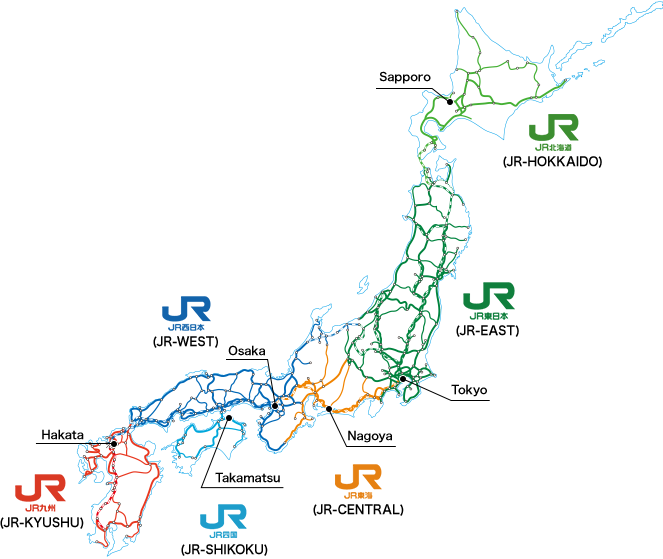
The Japan Railways Group railways:
Five Essential Japan Rail Pass Tips
1. Buy For the Lowest Possible Price
Don’t overpay for your Japan Rail Pass. Instead, make sure you order your pass from a Japan Railways Group authorized sales agent like JR Pass, where the price, where the group sets the price and allows agents to sell for lower than their own website.
2. Create an Itinerary to Get the Most From Your Pass
Consider the validity of your rail pass before you finalize your itinerary to optimize the dates of rail travel during your trip. There is no need to pay for extra train journeys that your pass could have covered if you had only made a better schedule for your trip.
3. Redeem Your Exchange Order on Arrival
Save yourself time later in your trip by redeeming your exchange order upon arrival at the Japan Rail Travel Service Center at the airport. Then, you can activate your pass and even reserve train tickets to ensure you get the departure times you prefer.
4. Reserve Your Tickets as Early as Possible
At every point during your trip, reserve train tickets as early as you possibly can. From the moment you redeem and activate your pass to each time you make a plan or change a plan.
If you need to urgently catch a train, and opt to use the non-reserved cars, there is a chance that you will possibly need to stand for the journey. This can be inconvenient for shorter trips and downright exhausting for longer ones on packed trains. It is not uncommon to have residents and visitors filling up an aisle for a multi-hour Shinkansen journey.
5. Embrace the Flexibility of the Pass
The Japan Rail Pass provides unlimited journeys on some of the fastest trains in the world, with the ability to step on a train at a moment’s notice. But unfortunately, most Japan Rail Pass holders don’t fully appreciate the complete flexibility that the pass offers until after using it.
While you will need to book your hotels and other trip reservations based on a set itinerary, within given days of your trip to Japan, you have the flexibility to put the past to good use.
For example, while traveling in the Kansai region, if you are staying in Osaka or Kyoto, you could visit nearby Himeji Castle or have lunch or dinner in Kobe, reaching Kobe in only 12 minutes from Osaka, and all cities within an hour from each other by train.
This allows for last-minute decisions and itinerary additions that are much easier to consider with no additional cost.
Our Other Japan Rail Pass Guide Posts
This post is part of a series on the Japan Rail Pass, to educate yourself on everything Japan Rail Pass-related, read through the other posts below:











